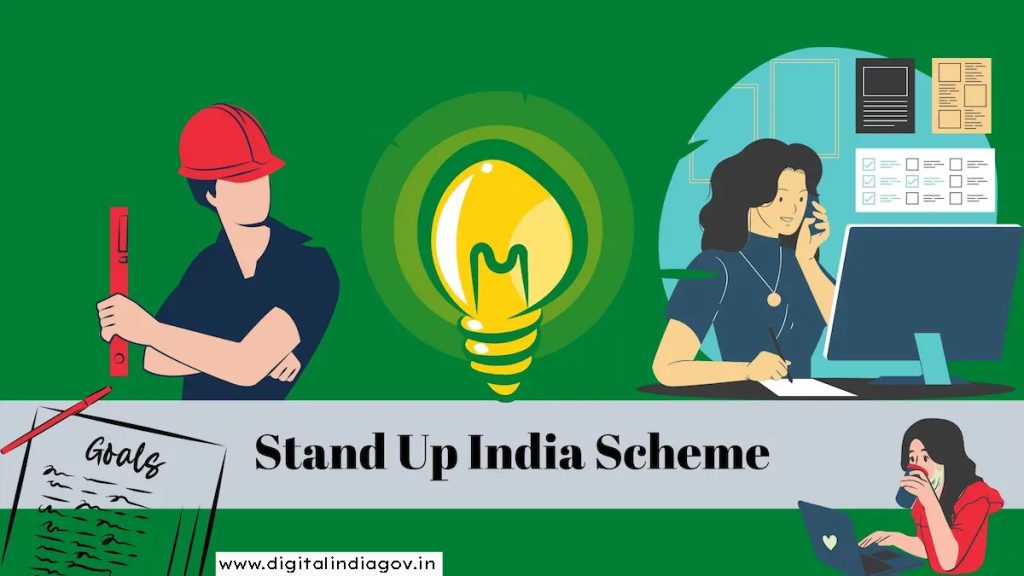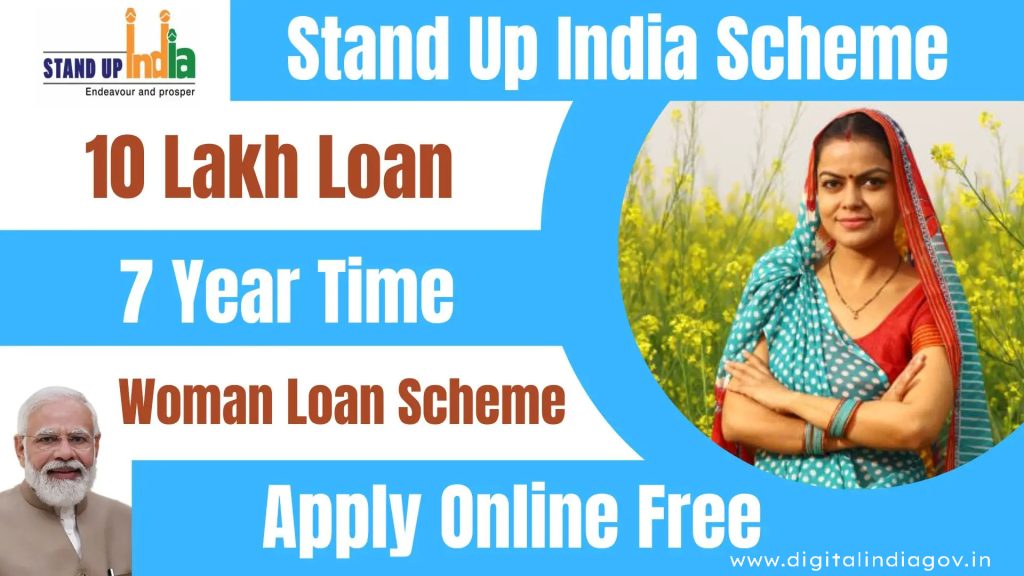Stand UP India Scheme:- The Prime Minister introduced the Stand Up India (SUI) initiative on April 5, 2016.
The program seeks to encourage women and members of scheduled castes or tribes to pursue entrepreneurship.
Under this scheme, bank loans in the amount of Rs 10 lakh to Rs 1 crore are available. A greenfield company in the manufacturing, services, or trading sectors is intended to be launched with the help of loans. Under the Stand-Up India program, loans ranging from Rs. 10 lakhs to Rs. Depending on their needs, women and people from the country’s scheduled castes and tribes will receive up to Rs. 1 crore. As per the plan, each of the 1.25 lakh bank branches would have to lend money annually to a minimum of one woman and one Dalit or tribal entrepreneur within their service area.
Also Read:- Pmegp Scheme
Contents
Key Features of the Stand Up India Scheme:
- The program is a component of the Ministry of Finance’s Department of Financial Services (DFS) drive to support entrepreneurial endeavors.
- A loan in the range of Rs. 10 lakhs to Rs. 1 crore, which includes working capital for starting a new business.
- According to the plan, each bank branch must, on average, support two entrepreneurial projects. One each for a woman entrepreneur and SC/ST.
- A RuPay debit card would enable the credit withdrawal.
- To make sure the money isn’t being used for personal expenses, the bank would monitor the borrower’s credit history.
- refinancing window with a Rs. 10,000 crore initial payment through the Small Industries Development Bank of India (SIDBI).
- This scheme creates a corpus of Rs. 5000 crore for credit guarantee through NCGTC.
- helping the borrowers by offering thorough pre-loan training assistance, including loan facilitation, factoring, marketing, etc.
- To help individuals with online registration and support services, a web portal has been developed.
- By extending bank loans to underrepresented groups in the population and starting new ones in the non-farm sector, the primary goal of this program is to strengthen the institutional credit structure.
- The program will benefit other Departments’ ongoing initiatives as well.
- The Dalit Indian Chamber of Commerce and Industry (DICCI) and the Small Industries Development Bank of India (SIDBI) will work together to lead the Stand Up India initiative.
- The National Bank of Agriculture and Rural Development (NABARD) and SIDBI will receive the designation of Stand Up Connect Centres (SUCC)
- For financial assistance, the Small Industries Development Bank of India (SIDBI) will receive an initial allocation of Rs. 10,000 crore.

Eligibility Criteria: Stand Up India Scheme
The following requirements must be met by the loan applicant in order to be eligible:
- It must be 18 years of age or older for the person.
- It has to be a partnership or a private limited company.
- The company’s revenue cannot exceed 25 crores ($25,000,000).
- An individual who belongs to a scheduled caste or scheduled tribe should be a woman entrepreneur.
- Only new projects in the manufacturing or service sectors will be eligible for the loan; otherwise, it will not be given.
- The candidate cannot be a defaulter on a bank loan or any other kind of organization.
- Commercial or innovative consumer goods should be the company’s area of business. Furthermore necessary for the same is DIPP approval.
Benefits of the Stand Up India Scheme
The primary goal of any program the government creates is to benefit the people, and this is also true of the Stand Up India program. The following are the advantages of starting the Stand-Up India program:
- The initiative’s main goal is to reduce unemployment by offering support, encouragement, and motivation to aspiring business owners.
- If you are an investor, Stand Up India provides the ideal forum where you can obtain legal expertise, time, and professional advice. They would also help you with the initial two years of your work, which is an added bonus.
- They also offer the consultants post-setup assistance.
- Furthermore, since borrowers must repay the loan over a period of seven years, entrepreneurs also benefit from not having to worry as much about how they will repay the amount borrowed. This eases the burden of repaying the loan. But a certain amount must be returned annually, at the borrower’s discretion.
- Additionally, this plan will assist in removing institutional, operational, and legal barriers for business owners.
- It has the potential to significantly increase employment and empower women, Dalits, and tribal people on a socioeconomic level.
- Other government initiatives like “Skill India” and “Made in India” might also be propelled by it.
- It will assist in safeguarding India’s demographic dividend.
- The financial and social inclusion of these social strata will result from bank account access and technological education.
Also Read:- Ladli Laxmi Yojana 2023- 24
Tax Benefits/Incentives in Stand Up India
- When the patent application form is filed, the applicants will receive an 80% rebate. Only startups are able to fill this, and they stand to gain more from it than other businesses do.
- There’s also the Credit Guarantee Fund, and entrepreneurs receive a reduction in income tax for the first three years at the very least.
- Regarding the Capital Gains Tax, entrepreneurs will have total relaxation.
- Additionally, the program offers benefits like tax redemption on profits earned to qualifying entities.
- This will make things easier for the entities during their first startup phase and relieve them of the burden of paying high tax bills.

Stand Up India Scheme: Challenges
Every new program or plan has a set of advantages and disadvantages. It’s the same with the Stand Up India Scheme. The following list includes the various issues with the Stand Up India program:
- There hasn’t been much focus on educating the public about the socioeconomic aspects of women’s and Dalit entrepreneurship. Failing to take this action could make the Stand Up India initiative less successful.
- One of the scheme’s requirements is that the business must be innovative. The DIPP retains the final say on whether or not a product qualifies as innovative. This could cause delays, which could lead to the loss of potentially lucrative business ventures.
- The business must generate a minimum of 25 crores in revenue. Few SC/ST-led businesses and women-led entrepreneurs meet this requirement.
- Self-help organizations, which have in fact given women entrepreneurs a boost, particularly in rural areas, have succumbed to local dominant interests and elite capture. The Stand Up India program makes no mention of any institutional measures to deal with these problems.
- Furthermore, there hasn’t been any significant banking sector penetration into the hinterlands yet. Therefore, despite Pradhan Mantri’s success, obstacles to bank account linkages may include the lack of institutional bank links, public awareness, the digital divide, and numerous other technical issues. Jan Dhan Yojana
- For the manufacturing sector, the funding support of roughly 10 lakhs to 1 crore is insufficient.
- Women and SC/ST people have not been sufficiently or significantly empowered in terms of tech expertise, labor market knowledge, or industry knowledge, among other areas.
Apply for a Loan under the Stand Up India Scheme
In order to apply for loans under Stand-Up India, candidates must go to the closest bank branch and inquire as to whether or not there is a one-person quota for SC/ST individuals or one woman entrepreneur per bank branch. If so, he or she can apply for a loan under the Stand-up India scheme by filling out the application and sending it in with the necessary paperwork. You can download the application form from the Standup India portal or standupmitra. in.
Steps to Register with the Stand Up India Scheme
Steps 1. Go to the official Stand-up India website at https://www.standupmitra.in/Login/Register.
Steps 2. Complete the registration form by first entering the address of the business, along with the state, district, town, city, village, and pin code.
Steps 3. Please indicate if the promoter is a woman and possesses a 51% or greater stake. The same goes for the SC/ST category.
Steps 4. The applicant can then choose from a drop-down list of first-time entrepreneurs, the type of business they intend to start, the amount of loan they would like to get, the type and description of their business activity, and the status of their space.
Steps 5. In addition, he or she must discuss previous business experience by mentioning the type of business, years of experience, and business activity.
Steps 6. The next step is to check the option that best suits your needs and interests for handholding support.
Steps 7. The applicant’s personal information, the name of the business, the user name, email address, mobile number, and the type of constitution are the last and final steps in the registration process.
Steps 8. Applicants can apply for the Stand-up India scheme with the relevant financial institution by clicking the “Register” button. An official will get in touch with them to complete any necessary formalities.
Also Read:- Ayushman Bharat Yojana 2023-24
Documents required
- properly completed application and passport-sized photos
- Identity documentation: voter ID cards, passports, driver’s licenses, PAN cards, etc.
- Evidence of residency may include a voter ID card, passport, the most recent phone and electricity bills, a property tax receipt, etc.
- Proof of business address
- Partners’ partnership deed
- Copies of the association’s last three years’ balance sheets; copies of the lease deeds or rent agreement
- The statement of assets and liabilities for the promoters and guarantors
- Any additional paperwork that the bank requires
Entrepreneurial support for Women and SC/ST communities
| Total Applications | 204732 |
| Total Amount | Rs. 48042.66 crore |
| Sanctioned Applications | 184206 |
| Sanctioned Amount | Rs. 41465.31 crore |
| Handholding Agencies | 24613 |
| Lenders On-boarded | 82 |
| Branches Connected | 137238 |
| HHA Requests | 3293 |
Bank’s List offering loans under Stand Up India
| Axis Bank | Indian Bank |
| Bank of Baroda | Indian Overseas Bank |
| Bank of India | Jammu & Kashmir Bank Ltd |
| Bank of Maharashtra | Punjab and Sind B ank |
| Canara Bank | PNB Bank |
| Central Bank of India | State Bank of India |
| ICICI Bank | Union Bank of India |
| IDIB Bank | Uco Bank |

FAQ’s
Q. How can I apply for Stand-Up India?
Ans- By visiting the closest bank branch, completing the loan application form, and sending it in with the necessary paperwork and photos, you can apply for a loan under the Stand-up India program.
Q. Is there any subsidy in Stand-Up India?
Ans- No, this scheme does not offer any subsidies. Attractive interest rates are available on loans covering up to 75% of the project cost from scheduled commercial banks, as well as private and public sector banks.
Q. What is the difference between Startup India and Stand-Up India?
Ans- Startup India is an online platform for entrepreneurs that helps new businesses use tools and resources and helps them build networks to help them grow and promote their enterprises. On the other hand, Stand-Up India provides loans to women and/or SC/ST entrepreneurs based on the project cost.
Suggested Link:- Mobile Number Tracker Online
@PAY
